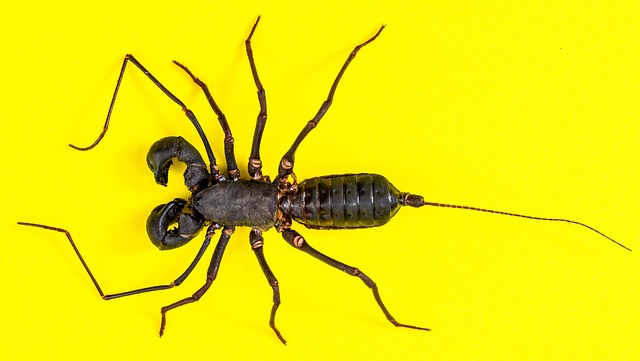Scorpions are nocturnal creatures, preferring cooler evenings for hunting and sheltering in dark, tight spaces during the day. Their preference for moist environments with high humidity or water leaks makes these areas hotspots for infestations. Effective scorpion infestation treatment relies on understanding their behavior, using tools like thermal imaging cameras, moisture meters, and gas detectors to locate nests, and conducting thorough inspections of hiding places such as rocky crevices, wall cracks, and dark corners under furniture. Targeted treatments, guided by knowledge of scorpion preferences, ensure successful control strategies.
“Uncovering Scorpion Nests: A Comprehensive Guide to Effective Infestation Treatment. Scorpions, with their reclusive nature, often hide in hard-to-reach areas, making thorough inspections crucial for effective scorpion infestation treatment. This guide explores the art of locating nesting grounds, from understanding these arachnids’ behavior to advanced techniques like thermal imaging. Learn about common hiding spots and gain insights into identifying potential hazards, empowering you to tackle scorpions head-on.”
Understanding Scorpion Behavior: When and Where They Hide
Scorpions are nocturnal creatures, preferring the cooler hours of the evening and night to hunt and move around. During the day, they seek shelter in dark, tight spaces, often remaining hidden until nightfall. Understanding their behavior is key when conducting thorough inspections for scorpion nesting and hiding areas.
In terms of where they hide, scorpions are known to favor rocky crevices, cracks in walls, under debris, and spaces behind appliances or furniture. They are particularly drawn to moist environments, so areas with high humidity or water leaks can be hot spots for scorpion infestations. Regularly checking these potential hiding places is crucial during inspections, as it helps in early detection of scorpion infestation treatment needs.
Visual Inspection Techniques to Spot Nesting Areas
Professionals in scorpion infestation treatment employ meticulous visual inspection techniques to locate nesting and hiding areas. This involves a thorough examination of the environment, paying close attention to intricate details that may be overlooked by untrained eyes. Skilled technicians use specialized equipment such as torches and high-powered magnifying glasses to scrutinize dark crevices, cracks in walls, and spaces behind furniture.
By moving methodically and observing carefully, experts can identify telltale signs of scorpion activity. This includes searching for fresh fecal pellets, which are distinctively shaped and left behind by scorpions. Additionally, they look for small holes or tunnels that might indicate the presence of a nest. Visual inspection also involves assessing the general habitat for factors that attract scorpions, such as moisture issues or food sources like insects or rodents.
Using Technology: Thermal Imaging and Other Tools
In the battle against scorpion infestations, technology plays a crucial role in identifying hidden nests and habitats. One powerful tool is thermal imaging, which detects heat signatures, allowing professionals to uncover scorpions hiding in crevices or under objects that may go unnoticed during visual inspections. By presenting a clear image of temperature variations, thermal cameras aid in pinpointing active areas where scorpions congregate.
Additionally, other advanced tools like moisture meters and gas detectors further enhance the process. Moisture meters are effective in locating water sources, which are essential for scorpion survival, while gas detectors can identify potential chemical treatments, ensuring safe and effective scorpion infestation treatment methods. These technological advancements offer a more comprehensive approach to understanding and eradicating scorpion habitats, contributing to successful scorpion infestation treatment strategies.
Common Scorpion Nesting Spots in Residential and Commercial Spaces
Scorpions are elusive creatures, often hiding in hard-to-reach areas, which makes them difficult to detect during initial inspections. In residential and commercial spaces alike, they tend to favor specific locations for nesting and shelter. Common spots include dark, secluded corners such as under furniture, inside cabinets, and behind appliances. Cracks and crevices in walls, floors, and ceilings are also favored hiding places. Outdoor areas, like garages, sheds, and compost piles, can attract scorpions seeking food or suitable habitats, especially during the warmer months.
For effective scorpion infestation treatment, it’s crucial to identify these nesting areas through thorough inspections. Professionals use specialized equipment and knowledge of scorpion behavior to locate hidden nests. Understanding these preferences allows for targeted treatments, ensuring a successful scorpion control strategy.
Inspecting for scorpions requires a multi-faceted approach. By understanding their behavior, employing visual inspection techniques, and utilizing advanced tools like thermal imaging, professionals can effectively locate nesting areas. With this knowledge, proper Scorpion infestation treatment can be administered, ensuring residential and commercial spaces are safe and free from these pests. Regular thorough inspections are key to preventing and managing scorpion infestations.
